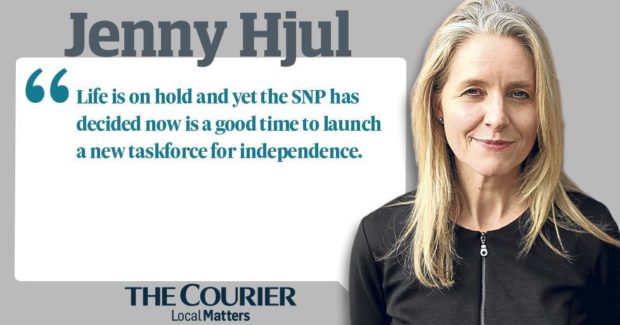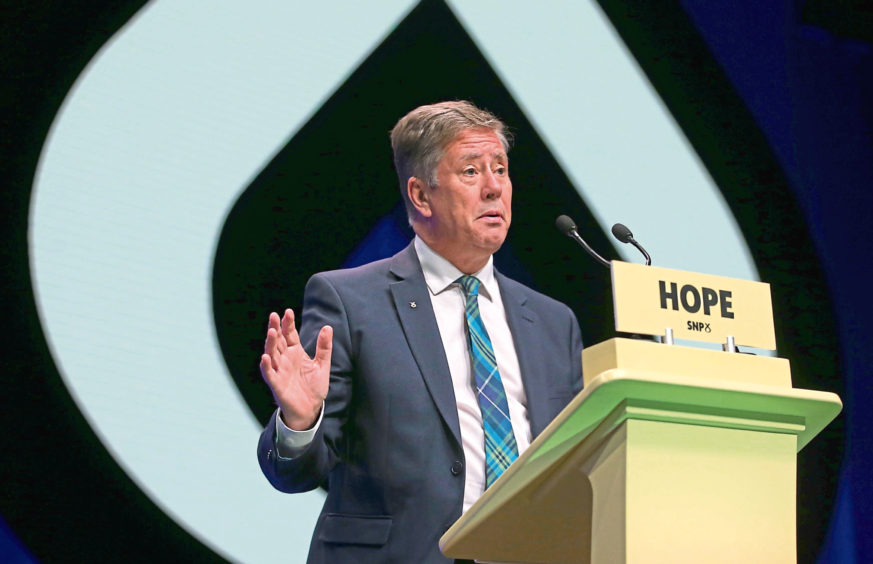What has changed in the past few days in Scotland’s battle with the Covid pandemic? We are still in a full lockdown, hospital admissions remain too high and our focus, we are told, must be on saving lives.
Scots are regularly upbraided, not least by the first minister and her loquacious public health experts, for any lapses in compliance with coronavirus restrictions.
“It is so important that all of us play our part in stopping this virus spreading,” said Nicola Sturgeon at her daily press conference on Monday.
Everything she could shut is shut, businesses are in limbo (the luckier ones) and schools are unlikely to open even next month.
Life is on hold and yet the SNP has decided now is a good time to launch a new taskforce for independence.
The party announced on Sunday that it was accelerating its bid to break up Britain by preparing for a second referendum in the early stages of the new parliament.
Its objective is to lay the foundations of the indyref2 campaign before the Holyrood elections in May.
The taskforce is to be led by a “high-profile and experienced ‘Yes’ campaigner”, said SNP deputy leader Keith Brown, and would publish policy papers, establish a national information service, and create campaign materials for “door-to-door activism”.
By “ramping things up” now, the nationalists no doubt hope to be able to hit the ground running come their anticipated electoral triumph in the spring.
Resumption of hostilities
It all sounds like a resumption of hostilities and the dispensing of the “we’re all in this together” delusion of the first months of the pandemic.
But how can there be a return to normal politics when, as Sturgeon herself keeps warning us, normal is a concept beyond our reach for the foreseeable future?
Whether right or wrong, she has persuaded Scots that death still stalks us, that demand for Covid beds threatens to overwhelm the NHS, and that our only hope of escape from the current misery is the roll-out of vaccinations.
People are anxious after almost a year of being advised to be anxious; they are worried about their livelihoods as well as their health; and most recently, they are probably beginning to panic about when they will be inoculated.
Scotland still struggling
In England, the 70s and over will be receiving invitations for their jabs this week – in Scotland, we’re struggling to get round the octogenarians.
Official figures showed that 750,892 first doses were administered south of the border between Friday and Sunday compared with 40,151 in Scotland, proportionately almost half the rate.
Around 2,000 fewer people a day were injected here over the weekend.
Many of our most fragile citizens, whose freedom depends on them being vaccinated, will be wondering why their counterparts in England are so much closer to receiving protection, and to family reunions, than they are.
Scottish ministers have come up with a few excuses and will probably invent a few more, but with their minds once more on constitutional upheaval, it appears that Scotland’s vital shot in the arm is not the priority it should be.
A vaccination taskforce instead
If Sturgeon had unveiled a vaccination taskforce over the weekend – or, better still, the weekend before – even her critics would have rejoiced.
Instead, we are belatedly relying on the British Army to help get our programme on track and speed up the delivery of Scotland’s share of the Pfizer or Oxford vaccines, provided by the UK Government.
It is no wonder Sturgeon looked uncomfortable at Monday’s BBC briefing when quizzed about her government’s poor performance on meeting this most crucial of targets.
It was she who just last week welcomed “healthy competition” between the UK nations in getting out the vaccine.
She will surely be regretting such bravado today, and regretting, too, her rush to put another independence referendum back on the agenda when voters are preoccupied with the fight against Covid.
What the polls revealed
Asked in a poll how much they agreed that the Scottish Government should prioritise dealing with the recovery from Covid-19 before an independence referendum, 78% of people said they either “strongly” or “somewhat” agreed, while only 7% said they “strongly” or “somewhat” disagreed.
And two-thirds of SNP voters said they would prefer the Scottish Government to prioritise Covid recovery over a vote, while 8% said the opposite, in the Survation survey, conducted before Christmas for the Scottish Labour Party.
Perhaps when Sturgeon signed off the new taskforce she expected the virus to be in retreat – more likely she felt cornered by the opposition forces within the secessionist movement who despair of her caution and are conspiring for her removal.
Whatever, to a beleaguered nation it was a heartless miscalculation.
What Scotland needs least at the moment is further self-obsession from a party driven by its own, not the country’s, interests.




